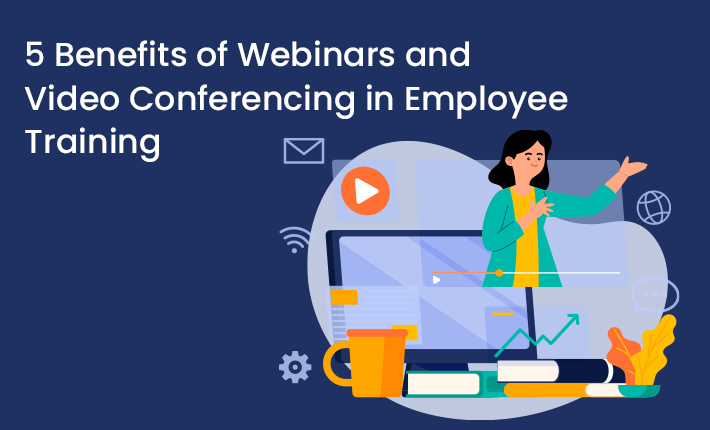In today's fast-paced world, employee training has evolved from traditional classroom settings to digital platforms, and webinars and video conferencing have emerged as powerful tools in this domain. Whether you are a small business owner or a corporate executive, incorporating webinars and video conferencing into your employee training programs can yield numerous benefits. In this article, we will explore 5 Benefits of webinars and video conferencing in employee training. Firstly, webinars and video conferencing provide flexibility, allowing employees to access training sessions from anywhere, at any time, eliminating the need for travel or scheduling conflicts. Secondly, these platforms offer interactive features that enhance engagement and participation, promoting a more effective and immersive learning experience. Thirdly, webinars and video conferencing enable real-time collaboration among remote teams, fostering teamwork and knowledge sharing. Additionally, these technologies allow for cost-effective training solutions, eliminating the need for expensive venues or printed materials. Lastly, webinars and video conferencing provide valuable analytics and data, allowing organizations to track progress and measure the effectiveness of their training programs. Discover how webinars and video conferencing can revolutionize your employee training experience and drive success in your organization.
The rise of webinars and video conferencing in employee training
Webinars and video conferencing have gained significant popularity in recent years as effective tools for employee mentorship and learning. With the advancements in technology and the increasing need for remote work solutions, these platforms have become indispensable for organizations looking to provide efficient and engaging training experiences. The convenience and flexibility offered by webinars and video conferencing have revolutionized the way businesses approach employee training. Gone are the days of outdated training manuals and boring PowerPoint presentations. Today, organizations can deliver dynamic and interactive training sessions that capture the attention of employees and enhance their learning experience.
5 Benefits of Webinars and Video Conferencing in Employee Training
1. Cost-Effective Training Solution
One of the primary benefits of using webinars and video conferencing in employee training is the cost-effectiveness they offer. Traditional training methods often involve renting expensive venues, printing materials, and travel expenses. With webinars and video conferencing, these costs are significantly reduced or even eliminated. Training sessions can be conducted online, saving both time and money. Employees can participate from their own workstations or even from the comfort of their homes, eliminating the need for travel arrangements. This cost-effective approach allows organizations to allocate their resources more efficiently and invest in other areas of employee development.
2. Increased Accessibility and Flexibility
Another advantage of webinars and video conferencing in employee training is the increased accessibility and flexibility they provide. Unlike traditional classroom training, where employees have to be physically present at a specific time and location, webinars and video conferencing allow participants to access training sessions from anywhere, at any time. This eliminates scheduling conflicts and ensures that employees can engage in training without disrupting their regular work responsibilities. Whether an employee is located in a different office or working remotely, they can still participate in training sessions and benefit from the knowledge and expertise being shared.
3. Enhanced Engagement and Interaction
Webinars and video conferencing also offer interactive features that enhance engagement and interaction during training sessions. These platforms allow for real-time chat, polling, and Q&A sessions, enabling participants to actively participate and ask questions. This interactivity promotes a more effective learning experience, as employees can engage with the material and seek clarification on any areas of confusion. The ability to engage in discussions and collaborate with fellow participants also fosters a sense of community and teamwork, even in remote training settings. By incorporating interactive elements, organizations can ensure that their training programs are engaging, memorable, and impactful.
4. Improved Knowledge Retention
In addition to engagement, webinars and video conferencing contribute to improved knowledge retention. Studies have shown that interactive training methods, such as those facilitated by webinars and video conferencing, result in higher retention rates compared to traditional passive learning methods. The combination of visual and auditory stimulation, along with the ability to interact and participate, enhances information processing and retention. Employees are more likely to remember and apply the knowledge gained during training sessions, leading to improved job performance and productivity.
5. Real-Time Collaboration and Feedback
Furthermore, webinars and video conferencing enable real-time collaboration and feedback among remote teams. In today's globalized workforce, many organizations have teams spread across different locations or even different time zones. Webinars and video conferencing provide a platform for these teams to come together virtually and collaborate on training exercises or projects. This not only fosters teamwork but also facilitates knowledge sharing and the exchange of ideas. Participants can provide immediate feedback and suggestions, allowing for a more iterative and agile approach to training. The ability to collaborate in real-time enhances the learning experience and ensures that employees are equipped with the most up-to-date information and skills.
Best Practices for Successful Webinars and Video Conferencing in Employee Training
To successfully incorporate webinars and video conferencing into employee training, organizations should follow best practices. Firstly, it is essential to have a clear training objective and structure in place. Define the desired learning outcomes and create a detailed agenda for the training session. This will help keep the training focused and ensure that participants gain the necessary knowledge and skills. Secondly, choose the right tools and platforms for hosting webinars and video conferences. Consider factors such as ease of use, reliability, and scalability. Select a platform that offers the features you need, such as screen sharing, recording capabilities, and interactive elements. Additionally, provide clear instructions and technical support to participants to ensure a smooth and seamless training experience.
Tools and Platforms for Hosting Webinars and Video Conferences
Several tools and platforms are available for hosting webinars and video conferences. Popular options include Zoom, GoToWebinar, Microsoft Teams, and Cisco Webex. These platforms offer a range of features and functionalities that can enhance the training experience. From screen sharing and whiteboarding to breakout rooms and audience analytics, these tools provide everything needed to deliver engaging and impactful training sessions.
Conclusion
In conclusion, webinars and video conferencing offer numerous benefits of employee training and development. They provide a cost-effective solution, increased accessibility and flexibility, enhanced engagement and interaction, improved knowledge retention, and real-time collaboration and feedback. By harnessing the power of these technologies, organizations can transform their training programs and drive success. Whether you are a small business or a large corporation, incorporating webinars and video conferencing into your employee training strategy can revolutionize the way you educate and empower your workforce. Embrace the digital era of training and unlock the full potential of your employees.






Leave a reply